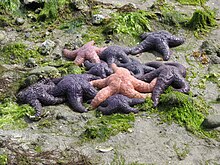Pisaster (from Greek πίσος, "pea", and ἀστήρ, "star"[1]) is a genus of Pacific sea stars that includes three species, P. brevispinus, P. giganteus, and P. ochraceus. Their range extends along the Pacific coast from Alaska to southern California in the intertidal zone. The largest individuals of Pisaster can reach diameters of up to 70 cm (28 in) across; they all develop five arms, but some may be lost from injury or disease, and occasionally the re-growth of an injured arm will result in an individual with more than five arms.
| Pisaster | |
|---|---|

| |
| Pisaster brevispinus | |
| Scientific classification | |
| Domain: | Eukaryota |
| Kingdom: | Animalia |
| Phylum: | Echinodermata |
| Class: | Asteroidea |
| Order: | Forcipulatida |
| Family: | Asteriidae |
| Genus: | Pisaster Müller and Troschel, 1840 |

Sea stars in the genus Pisaster are all predators; the ochre sea star is the best-characterized of these, and is considered a "keystone" predator that controls the relative abundance of many other species in the ecosystem.
Species edit
| Image | Scientific name | Common name | Distribution |
|---|---|---|---|
| Pisaster brevispinus | (Giant) pink or short-spined sea star | coast of North America from Sitka, Alaska to La Jolla, California. | |
| Pisaster giganteus | Giant sea star | coast of North America from Southern California to British Columbia. | |
| Pisaster ochraceus | Ochre sea star | from Prince William Sound in Alaska to Baja California. |
References edit